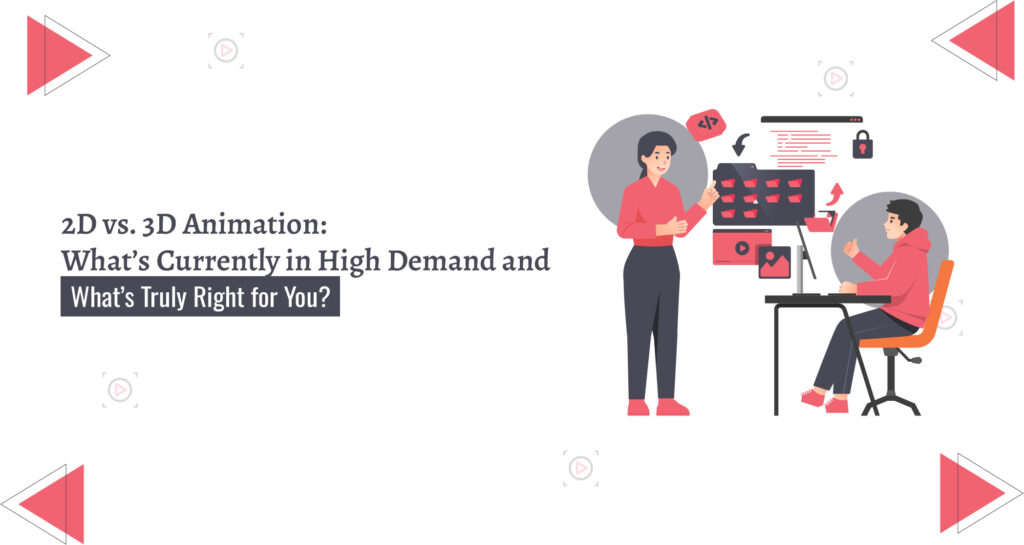What is 2D Animation? A Complete Guide to Everything You Need to Know
2D animation is a classic and versatile form of animation where images are created and manipulated in a two-dimensional space. Unlike 3D animation which adds depth through three-dimensional models, 2D animation relies on creating movement using flat, graphical elements. What is 2D Animation? 2D animation revolves around the creation of flat, two-dimensional images that simulate motion through rapid succession. Unlike three-dimensional objects that possess depth and volume, 2D shapes are defined solely by their length and width, lacking thickness. Within the realm of 2D animation, characters, objects, and backgrounds are meticulously crafted and animated within this flat plane. This animation style finds extensive application across various media formats such as movies, cartoons, advertisements, presentations, educational videos, and video games. Its inherent simplicity and versatility render it a favored choice among storytellers and content creators seeking to convey narratives in a visually engaging manner. The process of 2D animation typically involves the sequential display of individual frames, each slightly different from the previous one, to create the illusion of continuous motion. This technique, rooted in traditional animation principles, relies on skillful manipulation of shapes, colors, and timing to bring characters and scenes to life. History and Evolution of 2D Animation 2D animation, an age-old technique originating in the late 1800s, initially involved artists meticulously drawing each frame using pencils. These drawings were then transferred onto transparent plastic sheets known as cells and photographed individually. Historically, 2D animation required artists to create numerous drawings, with subtle variations between each, to depict movement fluidly. These sequential images were then played in rapid succession to achieve the desired animation effect. Today, advancements in computer software have significantly streamlined the 2D animation process. This technology allows for more detailed and imaginative visual storytelling, enhancing the depiction of creative ideas. Since its inception with films like ‘Fantasmagorie’ in 1908, 2D animation has evolved dramatically, spanning countless cartoons and flash animations. Despite the rise of 3D animation, 2D retains its allure by transporting viewers into fantastical worlds through imaginative representations. Over the decades, the labor-intensive nature of 2D animation has become more efficient. While 3D animation continues to grow in popularity, 2D animation maintains its unique appeal and irreplaceable charm.” Why is 2D Animation Used? Despite the advent of 3D animation, many individuals and businesses continue to favor 2D for its inherent advantages. One of the primary reasons is its cost-effectiveness producing 2D videos is generally more economical compared to 3D. Additionally, 2D animation projects tend to be quicker to produce. The simplicity of 2D animation also means it requires less sophisticated technology and software, making it accessible and straightforward to work with. This streamlined production process saves time and effort, as the guidance and resources needed for 2D animation are moderate. Furthermore, 2D animation offers creative freedom without technical constraints, contributing to its widespread use in animated movies and other media. Its simplicity not only facilitates production but also enhances profit margins, making it a preferred choice for many content creators. 2D Animation Techniques and Methods Since Emile Cohl’s pioneering animation, the techniques of 2D animation have advanced significantly, streamlining the process. Despite the complexity, creating even a few seconds of animated video involves extensive methods. Modern advancements, such as using software like Harmony, have simplified coloring for hand-drawn animations. Various drawing and painting applications, including bitmap and vector graphics, play pivotal roles in traditional animation creation. Moreover, a multitude of techniques contribute to crafting finely detailed animated videos, some of which are explored further below. The Cel Technique in Animation The cel, a traditional animation technique pioneered in 1915 by American animators Earl Hurd and John Bray, involves drawing and painting objects on a transparent sheet known as a cel. Originally made from celluloid, a compound of camphor and nitrocellulose, cels later transitioned to cellulose acetate, an ester of cellulose, due to its cost-effectiveness. The Limited Edition Exploring its Significance In Limited-Edition animation, only specific parts, like the character’s mouth for speech, are repainted, not the entire figure. This method optimizes production time and resources. It ensures consistent quality while reducing costs associated with full redraws. This approach is instrumental in maintaining efficiency and meeting deadlines in animation production. By focusing on key elements, animators achieve swift updates without compromising animation quality. Process of 2D Animation How they are created The process of 2D animation unfolds through a series of distinct stages that collectively bring an animated project to life. 1. Pre-production2. Production3. Post-production 1. Pre-production: This initial phase lays the groundwork for the entire animation. It includes concept development, scriptwriting, storyboarding, character design, and setting the overall visual style. Pre-production is crucial for establishing the narrative structure and visual identity of the animation. 2. Production: In this phase, the actual animation creation takes place. It involves tasks such as animatics (animated storyboards), creating keyframes and in-between frames, coloring, and adding details. Traditional hand-drawn animation may involve using cels or digital tools for frame-by-frame creation, while modern techniques often employ digital software like Adobe Animate or Toon Boom Harmony. 3. Post-production: Once the animation sequences are completed, post-production focuses on finalizing the project. This stage includes activities such as editing, adding sound effects, music, voiceovers, and special effects. It aims to enhance the overall coherence and impact of the animation before its final release. 2D Animation Examples There exists a rich legacy of well-known cartoons and influential business videos created in the distinctive 2D animation style, each contributing to the medium’s enduring popularity and impact. Cartoons: Business Videos: Beyond entertainment, 2D animation has also proven invaluable in business communication and marketing. Companies utilize animated videos to explain products, services, and complex concepts in engaging and accessible ways. These animations leverage the visual clarity and narrative flexibility of 2D animation to effectively convey information and captivate audiences. The enduring popularity of these cartoons and the effectiveness of business videos demonstrate the versatility and enduring appeal of 2D animation showcasing its ability to entertain, educate, and inspire across different contexts and audiences. List of 2D Animation


